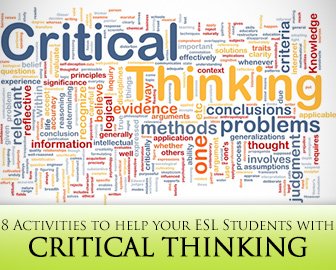Thinking Outside the Blank: 8 Critical Thinking Activities for ESL Students


The students are polite and engaged and usually come from cultures where teachers and the education process is respected. Often measurable progress can be seen in one semester in an ESL class, which is not always the case in other disciplines which are developmental in nature. Students bring in a variety of ideas and information from multiple cultural backgrounds.
However, there can sometimes be a feeling of something missing, almost as if the class sessions go too smoothly. There is little to no dissent among students, and activities are completed without questions or complaint.
The missing element may be critical thinking: that engagement from students at a critical and analytical level, considering questions more deeply, often engaging in debate with the topic itself and with other students. A large part of education in general is to move beyond one’s comfort zone to consider positions and ideas that may be uncomfortable and create disagreement—the elements that develop critical thinking and habit of looking at issues analytically.
Often, because of a combination of reasons, ESL classes fail to engage student critical thinking.
Many cultures, Nonwestern ones in particular, have more of a tradition to seek consensus and keep harmony than in Western traditions, which focus more on exploring issues, often by taking opposing sides. Indeed, we have in English expressions such as “just for the sake of the argument—” or “to play devil’s advocate—” which imply exploring opposing views for the sake of the debate, the argument. While many people from Western cultural traditions are familiar with this method of exploring issues, it may be highly uncomfortable for students raised outside of that tradition.
Students from second language backgrounds may not engage with or do well with exercises and activities that demand critical analysis because of the linguistic demands. Exploring an issue critically involves usually speaking and/or writing at length on a topic, from various perspectives, offering examples and details and explanation. Many ESL students have not yet developed their English skills enough to explore issues in depth.
The curriculum of ESL classes has sometimes been called “the curriculum of subservience.” That is, the course materials have traditionally been focused on preparing students for holding low-status service jobs, so there are limited activities focused on critical analysis but rather on tasks that require understanding and following directions: the antithesis of critical thinking exercises in that students are taught to do as told, without questioning or considering other possibilities.
Often the activities in ESL classrooms, along with the materials, are focused on “survival skills,” such as how to shop for clothes and food, go to the bank, order in a restaurant, talk to one’s doctor, and so forth. Again, there is little focus on critical thinking and analysis involved in these topics but rather more modeling of the “correct” way to perform the tasks.
While the cultural background students bring to class can only be addressed in a limited way, there are ways to address student linguistic needs and class activities, materials, and instruction to get students engaged in critical thinking.
Go over with students the purpose critical analysis, how to do close readings of a text, how to discuss its various interpretations, and discuss why and how to how to engage in a debate and entertain varying perspectives. Teach such skills as annotating a text and asking questions about the text as one reads: what is primary thesis is and what some opposing views might be.
Teach and model questions and answers for critical thinking. Students may be used to asking and answering straightforward questions that require only short responses. Teach responding at length, asking questions that require thought to respond to, such as the “why” questions that require interpretation and analysis.
Give out readings that require more analysis and that have more than one interpretation, questions that have more than one answer. Many students, for example, have gone through school not having read much beyond personal narratives/life stories. While these have some value, especially if the writer was a notable person or living through an important historic event, often little critical thinking is involved in presentation of personal narratives, and the discussion remains on the factual level or exploring the emotional impact of the text. Consider writings on issues, which may have some or even a lot of personal narration, such as Staples’s “Black Men in Public Space,” but the narration of the author’s experiences in how people to react to him in public is to highlight an issue, that of racism.
Students who are second language learners in particular need enough time formulate thoughtful responses. Wait while the student forms a response, although the impulse might be to rush in and help him or her answer.
Often second language students are very articulate in writing while having difficulty speaking because of the need for time to compose a response. Consider allowing students to form a written response first before discussing it. The question may be very simple: e.g., “What did you think about the film?” but may have requirements on the time and/or length spent on responding to the question.
Critical thinking skills and engagement do not happen quickly but require sustained effort, extending activities across class periods and into homework. Extended class activities may go from discussion to writing, for example, on a topic, or following up with discussion on a topic with further research on that topic at home. Extending activities like this will get students to continue considering the question, gaining more information on it, and learning different perspectives.
Critical thinking activities and development of critical/analytical skills do not occur naturally in the ESL classroom but rather require careful planning on the part of the teacher and practice from the students. However, by teaching students the process of critical and analytical reading and writing skills as well as using appropriate materials and methods, teachers can help students develop the habit of thinking critically.